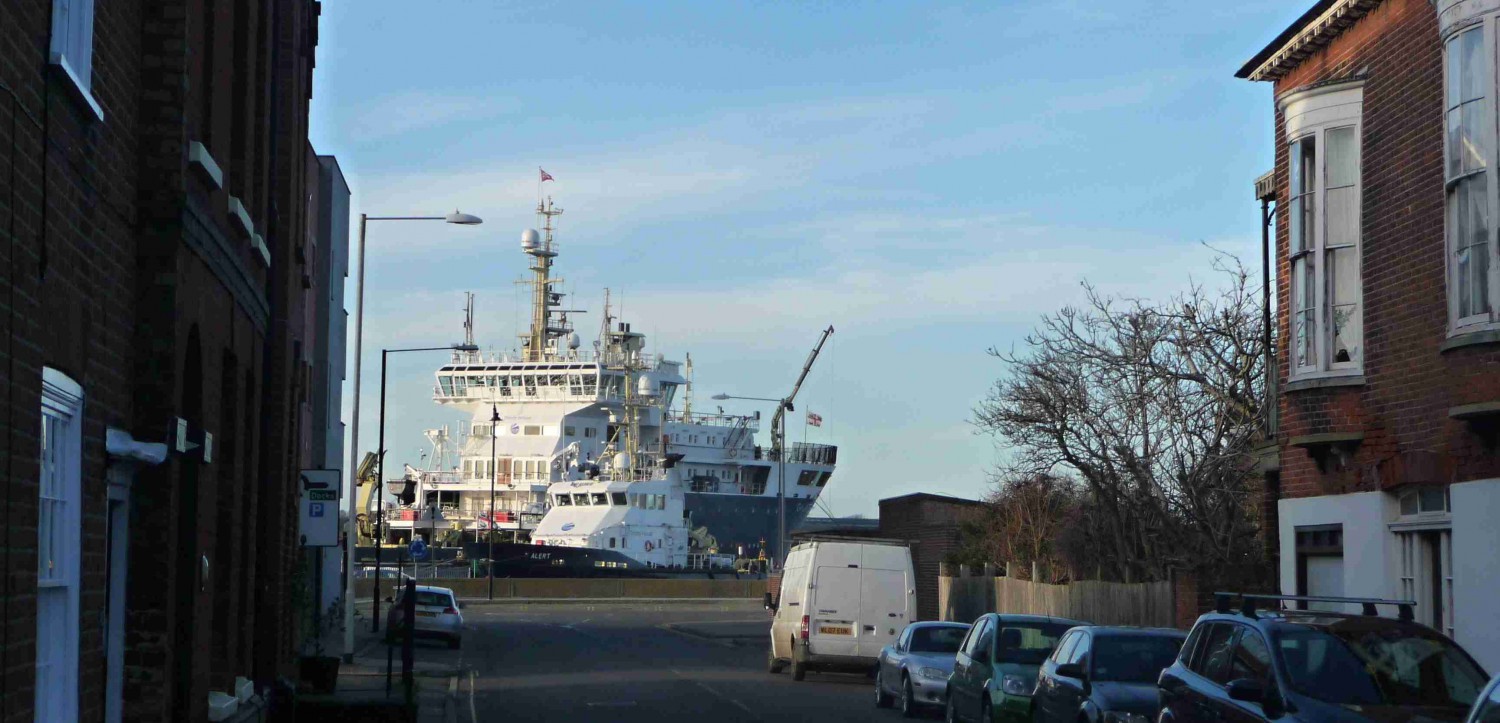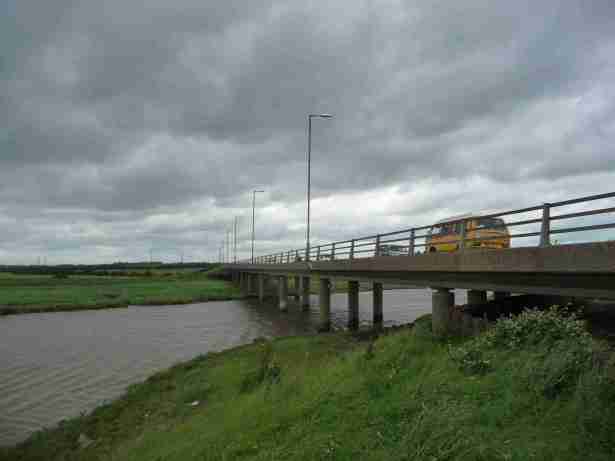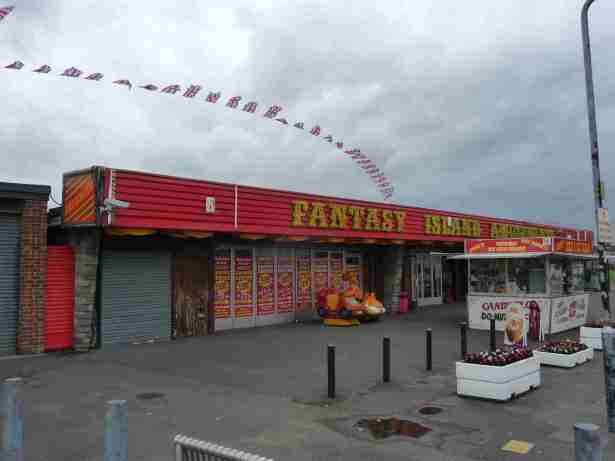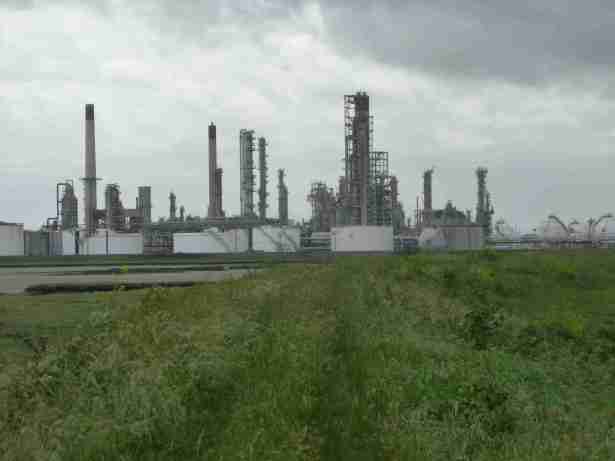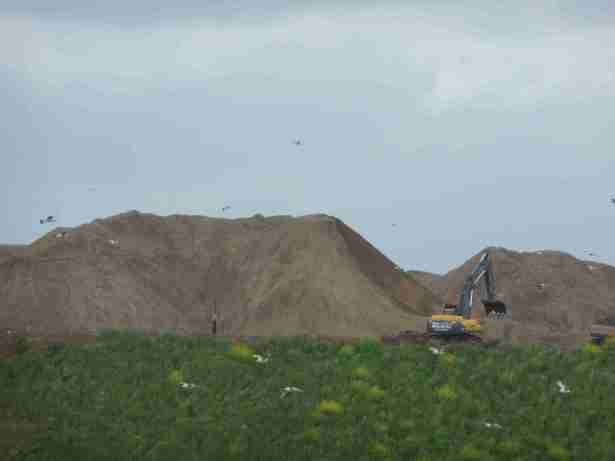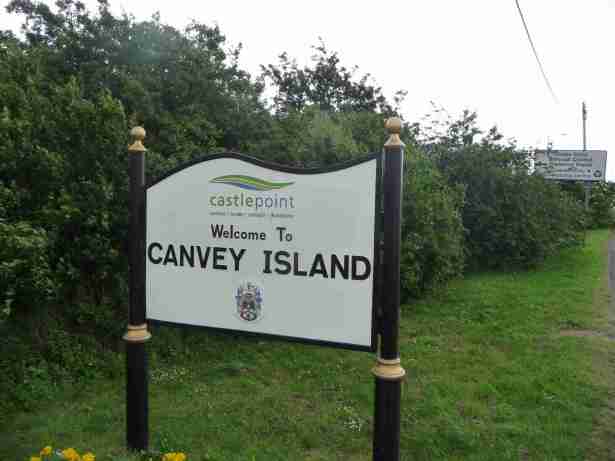Canvey Island 8th June 2012
It always does it. Just as you are nearing the end of a walk, fixing your eyes on a destination a few hundred yards away (and you can nearly always see your destination from a distance on the Essex coast), the sea wall does an unanticipated swerve, so the pub, station or whatever you’re heading towards, is suddenly behind you, while you undertake a two-kilometer extension. We know this by now, because it has happened to us many times, and, even though we are not purposive, A to B walkers, it can get to you when it happens at the very end. As it does today. Passing under the ‘Canvey Island Way’ dual carriageway, still on the sea wall, we can see the masts of the marina and South Benfleet station representing the end of our walk, close across the marshes. What we can’t see is the creek that lies between us, and the diversion the wall has to make to get round it. The final kilometer seems interminable. This might be one dimension to ‘The paradox of progress’ – a theme I’ve been trying to work in – in the sense that sometimes you have to go backwards to get where you want to go, although I think the problematic nature of the idea of ‘progress’ is probably beyond the scope of this blog.
Which is a churlish way to start a post, for there is no more bracing place to be than Canvey Island when it is being ripped by 30 mph westerly gales. Whilst we are heading east, this is not a problem, but as we pass around the Canvey marina to the southern side of the island, we are in the teeth of the wind. Passing the Concord beach, all fifty yards of it, we are blasted by sand; half of the tarpaulin that covers the dodgems on Fantasy Island has been sheared and the other half looks as though it might follow suit. The jubilee flags and union jack bunting strain at their fastenings and it seems inevitable that they will be stripped and blown out to the German Sea to disappear beneath the waves without a trace, perhaps sinking slowly and miserably in quicksand. The birds have a particularly hard time – on the nature reserve at the north-west of the island we spot an egret stationary in the air a few feet above our heads, attempting to fly against the wind. It turns and is five hundred yards away in seconds. A heron has an even worse time of it – rising out of the grass at our approach, floundering and helpless, it flaps like a tablecloth torn from a clothesline before somehow negotiating a landing some distance away. It would certainly not be a good day to be born a butterfly.
Ebb Tide, Master F. and myself meet in the cafe next to South Benfleet station, where the proprietor talks us round our proposed route. He has cycled a lot of it, but seems a bit surprised that anyone would want to walk round the island. It’s a good walk, he assures us. Look out for the Canvey Downs, which are nice, and the oil refinery is OK as long as you’re looking over the river with your back to the tanks. “Good luck” he wishes us, perhaps somewhat pityingly, as we set off.
Our walk starts on a path between the Benfleet marina and the Canvey golf course, and the wind is behind us. Leigh-on-Sea and Southend lie ahead of us to the north, and Southend pier stretches across the mud on the horizon. The sea wall at Canvey is proper sea wall, real bulwark built to withstand the direct assault of the tide because Canvey, entirely below sea level, and being the most highly populated of the Essex islands, suffered particularly badly in the 1953 flood, there are memorials to the 58 people who died during the inundation, and to this day, water drainage and population evacuation are high priority on the island.
Passing the golf course, we walk around the Canvey Downs, a former landfill site, now grass covered, (and which, Ebb Tide points out, are approximately eight feet above sea level), past the substantial Canvey Marina. At the Eastern tip of the island we can see a three-masted tall ship lying in the estuary. Apparently there had been some kind of boating event on theThames the previous Sunday, and Ebb Tide reckons that this, rather impressive vessel, is probably a straggler. The front at Canvey is compact and empty. Given the windy day, it’s not surprising that the beach is almost deserted, and the amusement park closed, but there are few people sheltering in the pub (The Monico) or in the cafes. A man standing outside the pub is worried about the wind because he has just bought a new boat which he has to take to its mooring at Battlesbridge tomorrow. That’s quite a journey, involving finding your way through the Maplin sands, and his concern is well-founded. The main beneficiaries of the weather are the wind-surfers on the river, zigzagging across the white-caps at high speed.
Rounding a bay towards the oil refinery, we spot a parent gallantly playing with his two small sons on the inhospitable beach. “Time to go now” says the long-suffering dad, “before the tide comes in”. High tide is at least two hours away, and Master F. is particularly impressed with this skilful parental ruse. This is Thorney Bay, known locally as ‘Saint Nowhere’, and bordered on it’s western side by Deadman’s Point.We are approaching the oil refinery, and take to the bottom of the sea wall on the river side. The narrow footpath disappears at various points, and we have to take to the sloping wall to get round various obstacles, and under jetties, just managing to stay above the seaweed line. I’m disappointed in the quality of the graffiti on this part of the wall; it is a vast blank canvas which any assiduous graffiti artist could improve on, unmolested by authority, for hours at a time. We are in sight of Tilbury power station here, and I would suggest that a suitable theme might be a serialised representation of Conrad’s Heart of Darkness, which was narrated from the deck of a ship lying off Tilbury. I’m not sure how this would lend itself to graffiti stylisation, but I’m sure it could be done.
The wall curves onto onto Holehaven Creek, and we are directly opposite the refining complex of Coryton, or, rather, former refining complex, for, on the day of our last walk, whilst we were gaily sunning ourselves on Southend front, Coryton announced 850 redundancies. The main back stories to this closure, as reported in The Guardian financial pages, appear to be global overcapacity, and unfortunate entrepreneurial complacency on the part of oil majors;
…refining is the necessary Cinderella of the oil industry and refineries are extremely complicated and expensive plants to run. The margins on a barrel of petrol or diesel made in Europe have been relentlessly falling, from a high of more than $6 in early 2010 down to $1.60 at the end of 2011. Squeezed by rising crude prices on the one hand and government taxation, high competition at the pump and stagnant demand on the other, it has been virtually impossible to make the necessary investments in upgrading capacity needed to squeeze greater efficiency out of often elderly plants. As result, the major oil companies have been bailing out to concentrate on the upstream business, cheerfully optimistic that independents, such as Petroplus, would keep on refining their crude for them….there may be a message for western Europe; unless the major oil companies stop simply assuming that the independents will take care of refining for them, then western Europe may soon have very little refining capacity at all. Indeed, it was by buying all these refineries from the oil majors in the early part of the decade that Petroplus got so heavily into debt in the first place. And if you believe being reliant on the Middle East for crude oil matters, then being reliant on their refiners for gasoline, diesel and fuel for aeroplanes might matter just a bit more.
The broadsheet press also like to make a lot of the ‘grittiness’ of Essex culture, and the Guardian wheeled out the iconic Canvey guitarist Wilko Johnson to comment on the aesthetic aspect of Coryton “…bear in mind how marvellous that skyline is. If that goes,CanveyIsland is going to lose it’s western horizon… across the creek, it is a thing of beauty. It pisses over the Pompidou centre.”
As we move onto the ‘rural’ part of Canvey, fields and nature reserve, it becomes apparent that this was formerly industrial ground. Owned by the East England Development Agency, it was intended to be developed as an industrial estate, but these plans don’t seem to have materialised, and it is, in part at least, managed by the RSPB. Turning from Holehaven Creek into Easthaven Creek, huge flocks of seagulls mark a large landfill site which appears to occupy the eastern end of Bowers Marsh, across the creek. The grass on the sea wall is long, and the path doesn’t seem to be well-used on this stretch it is the quietest part of Canvey’s sea wall possibly, and quite rightly, because dog – walking and nature reserve are uneasy companions. There are plenty of dog-walkers on Canvey and in my opinion, they are a very friendly bunch. Walking, as we do, bears no resemblance to a television programme journey, in which local historians, specialist artisans or resident celebrities are wheeled out to meet the presenter and cast illumination on some aspect of the local culture; the people we meet are mostly dog-walkers, and you become something of a connoisseur of the quality of response you receive in exchanging greetings as you pass each other along the sea wall. The Canvey response is, I think, the warmest we have yet encountered, almost as if people are enthusiastic that rucksack-carrying, anorak-wearing, trekking trainer-clad, quorn scotch egg/pork pie – eating tourists are patronising their sea wall. As we pass back across the bridge to Benfleet, Master F. and myself stop to take photos of the ‘Welcome to CanveyIsland’ sign. We are hooted by passing cars, tourists in our home county.
Sadly, the day before this walk, Master F.’s stepfather died after a long illness, and this blog is dedicated to his memory, and to Master F., his mother and family.
